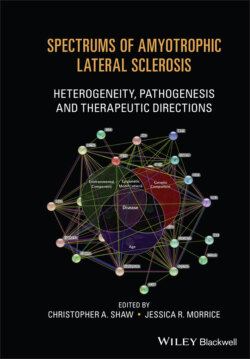Читать книгу Spectrums of Amyotrophic Lateral Sclerosis - Группа авторов - Страница 11
INTRODUCTION
ОглавлениеAmyotrophic lateral sclerosis (ALS) was first described in 1874 as a specific neurological disease by the French neurologist Jean‐Martin Charcot, who chose this term to reflect both clinical observations and post‐mortem pathological findings. Amyotrophic refers to clinical evidence of muscle atrophy as a consequence of the loss of lower motor neurons (LMNs). Lateral sclerosis refers to the pathological observation of hardness of the lateral columns of the spinal cord, following upper motor neuron (UMN) degeneration [1]. UMN degeneration is followed by the formation of a sort of scar. The disease leads to progressive paralysis, with death occurring due to respiratory failure within three to five years after symptom onset.
The classical form is characterized by the concomitant involvement of UMNs in the cerebral cortex and LMNs located in the brainstem and the spinal cord. Clinical manifestations of UMN damage are loss of dexterity of the hands and spastic gait associated with overactive tendon reflexes. These signs are frequently associated with pathological reflexes, including Chaddock and Babinski signs (extension of the big toe after rubbing the lateral malleolus and the sole of the foot, respectively) and Hoffmann sign (flexion and adduction of index finger and thumb when flicking the nail of the middle finger downward). Corticobulbar involvement leads to slurred speech and difficulty swallowing, often with pathological crying and laughing. The consequence of LMN degeneration is weakness, which may involve any muscle of the body including those of the tongue, pharynx, or larynx (innervated by bulbar motor neurons); those of upper and lower limbs; and the respiratory muscles. Oculomotor and Onuf's motor neurons are usually spared. Muscular atrophy, reduced reflexes, and signs of hyperexcitability in motor neurons, such as fasciculation and cramps, are additional features of LMN degeneration.
The combination of the these symptoms and signs of UMN and LMN dysfunction results in a peculiar and stereotypical picture, which in most cases is easy for expert clinicians to identify. However, there is an evident clinical heterogeneity among ALS patients, which is determined by several independent elements. The age of onset and survival, two major phenotype features, show a marked variability among patients. Furthermore, the relative number of UMN and LMN signs may show substantial differences. An additional contributor to this heterogeneity is the evidence that the types of cells impaired in ALS may extend beyond UMNs and LMNs to include the frontal and temporal cortex, extrapyramidal system, peripheral nerves, and skeletal muscles, giving rise to variable and sometimes overlapping phenotypes.
Finally, genetic research has revealed that ALS is linked with several causative genes – a list that will probably increase in the coming years due to the rapid improvement of next‐generation sequencing technologies. ALS‐related genes are implicated in various cellular functions, including RNA metabolism, autophagy, and axonal transport, suggesting significant heterogeneity in disease mechanisms as well.
Thus, it appears that ALS is used as an umbrella term referring to a spectrum of disorders with diverse clinical manifestations, heterogeneous disease mechanisms, and (probably) different responses to therapies. On the other hand, all ALS patients, except carriers of superoxide dismutase 1 (SOD1) and fused in sarcoma (FUS) variants, appear to be unified by a single pathological signature: the presence of abnormal accumulation of the transactivation response DNA binding protein (TDP‐43) in the cytoplasm of neuronal and glial cells [2].
